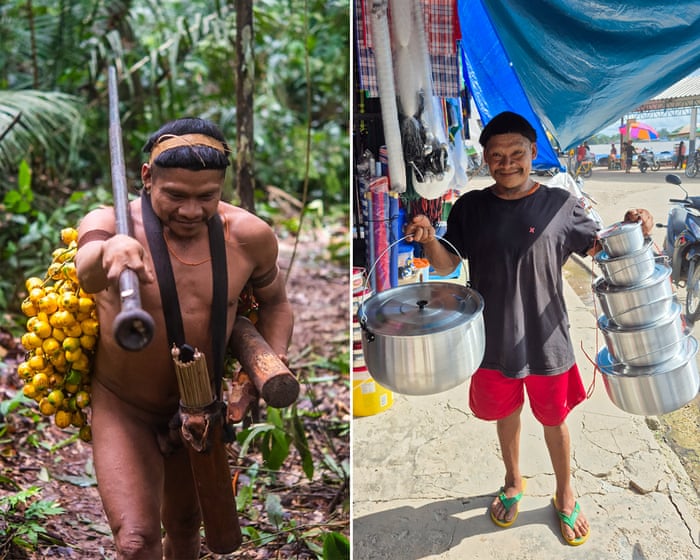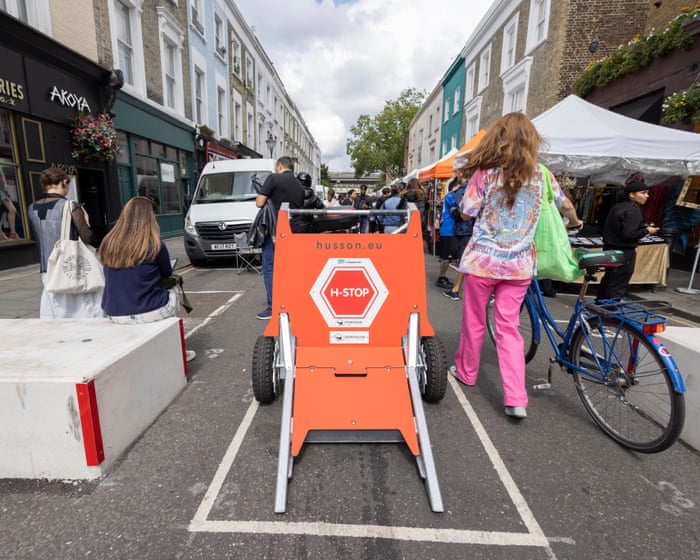Xuxu dreams of owning a large metal cooking pot—one big enough to fit an entire monkey. His people, the Korubo, once cooked their meals in heavy clay pots made in the forest. But lightweight metal pots brought by outsiders have become too tempting to resist.
A map shows the Javari Valley Indigenous Territory, located along the Brazil-Peru border in South America.
Xuxu first learned about Tabatinga, a town in Brazil’s Amazonas state, when he traveled there for treatment after a snakebite. He rolls up an armband on his muscular arm to point out where the snake struck him. His second trip was to take a sick grandchild for care.
Xuxu lives in one of four Korubo villages near where the Ituí and Itaquaí rivers meet in the Javari Valley. After initial contact with outsiders in 1996, 2014, and 2015, about 60 Korubo settled in these villages. Today, the village has grown to 127 people. Over the past decade, contact has brought new diseases, modern goods, greater safety from outside threats, and glimpses of the wider world.
The Korubo represent nearly all of Brazil’s recent first-contact encounters, offering a glimpse of what might happen if the Amazon’s remaining 60+ isolated groups emerge. Their lands were first invaded by rubber tappers in the late 1800s, followed by loggers in the 1900s. Unlike other Amazonian tribes, the Korubo fought back with wooden clubs instead of bows and arrows.
### What Are Uncontacted Peoples?
Uncontacted peoples, also called “peoples in voluntary isolation,” avoid modern society to protect their way of life and avoid violence or exploitation. They live in remote areas like rainforests and deserts, preserving their traditions without outside influence. Governments and organizations work to protect their rights and lands, preventing disease, cultural harm, and exploitation.
### What Counts as Contact?
In anthropology, “contact” means ongoing interactions between different groups. “Contacted” people maintain ties with the outside world. Contact can be direct (trade, conflict) or indirect (disease spread). Brief or accidental meetings don’t count—only sustained exchanges do. Historically, colonial contact often disrupted Indigenous cultures.
### Where Do They Live?
Most uncontacted groups live in the Amazon, especially Brazil and Peru, often in protected areas. Others are found in the Gran Chaco, Andaman Islands, North Sentinel Island, and West Papua. The Amazon basin—spanning Brazil, Peru, Colombia, and Ecuador—has the highest number of isolated communities, possibly dozens. Western Brazil and eastern Peru are home to some of the last uncontacted groups, many living in protected territories.
### Why Protect Them?
Some argue against protection, claiming uncontacted peoples miss modern benefits or that land use conflicts arise. Supporters say these groups thrive using natural resources, that contact harms their health, and that outside influences weaken their cultures. They stress these peoples’ rights to their lands and the risks they face if exposed. Even after contact, Indigenous groups often retain rights to their ancestral territories under national and international laws.
### Why Is This Controversial?
Governments and NGOs try to shield uncontacted peoples from logging, mining, and farming, which threaten their survival. Creating protected zones limits outside interference and preserves their way of life. In countries like Brazil, laws require safeguarding these territories.The government is required to mark Indigenous territories when uncontacted peoples are identified—a measure that often clashes with economic interests tied to land rights and use.
“They acted like protectors of the land,” says Fabrício Amorim, former coordinator of the National Foundation for Indigenous Peoples (Funai) in the Javari Valley. “They stood up against loggers armed with guns and boxes of ammunition, while the Korubo only had wooden weapons.”
From 1965 to 1997, the Korubo killed 25 non-Indigenous intruders in their territory. In response, outsiders launched at least 10 attacks, hunting, shooting, and poisoning Korubo people.
“We were in our longhouse when outsiders came and killed many of my family, including our elders,” says Xuxu. “That’s why we retaliated by killing fishermen.”
By the mid-1990s, the escalating violence led Funai to break its no-contact policy. Expedition leader Sydney Possuelo made first contact in 1996, capturing images of 18 naked Korubo individuals, led by matriarch Mayá, examining modern objects and trying on clothes.
Today, at least one Korubo group remains uncontacted.
In the yard of the Tabatinga Indigenous health center, Xuxu and his friend Txitxopi break branches from a tree to make seats for themselves and visitors. Repeated contact has created two social classes: xëni (originals) and paxa (newcomers). Xuxu is paxa. His hair is traditionally styled—shaved at the back with straight-cut bangs. He stifles laughter several times, amused by the conversation.
“We don’t like the city,” says Takvan, son of matriarch Mayá. “When we come here from the village, we often get sick. That’s why we’re pushing for Sesai [the federal Indigenous health agency] to build a proper clinic with doctors in our village.”
Though the Korubo have a health post in one village and a floating clinic near another, they still travel to the city for care—only to fall ill. Dr. Lucas Albertoni, Brazil’s chief official for recently contacted peoples, notes that Korubo now visit the city even for minor ailments—a shift from the past when convincing them to leave the forest was difficult.
“Now it’s the opposite,” he says. “I have to explain all the risks of coming to the city.”
Four Korubo infants have died in the past year. While the cause of two deaths remains unknown, preliminary reports point to common illnesses: flu, pneumonia, diarrhea, and dehydration.
“Biologically, we’re the same. Their immune systems aren’t weak,” Albertoni explains. “They just lack exposure to diseases common in our society.”
Years after contact, Funai tried to control the flow of manufactured goods to the Korubo, supplying only essentials like batteries, flashlights, machetes, and soap. But their idea of “needs” expanded. With money from Funai jobs and government aid, they bought boats, phones, rice, pasta, and biscuits. Since many Korubo don’t use numbers, Brazilian currency—featuring animals like the jaguar on the 50-real note—helps them track transactions.The Korubo people sometimes feel cheated when making purchases, as Takvan explains.
Now, the Korubo want solar panels to provide electricity for lighting, charging phones, and internet access. “Before mobile phones and the internet, when someone was taken to the hospital in the city—my son, my brother—we had no way of knowing how they were doing. Are they better or worse? How could we find out? That’s why we have mobile phones now, and we want Starlink,” says Txitxopi.
Two villages already have internet connections. Luisa Suriani, who teaches Portuguese and literacy in the villages, says attempts to limit internet access to certain hours didn’t work. “Now one village has internet available all day,” she says. “They’re naturally curious about everything from the outside world, so you can imagine how fascinated they are by the internet.”
The longhouse glows with screens, and Suriani notes that young people are becoming less interested in traditional survival tasks like hunting and farming.
Seatvo is the first Korubo to live in the city. When he met anthropologist Juliana Oliveira in Tabatinga, he wore tight jeans, spotless white sneakers, and sunglasses on his head. Once a translator at the health center, he’s now exploring new opportunities, possibly joining the army. Eventually, he hopes to train as a teacher and return home. “We’re tired of teachers who only stay for three months and then leave,” he says.
Suriani warns against romanticizing the Korubo or lamenting their so-called “pollution” by materialism. “When you live with them in the villages, you see how strong and unique they truly are,” she says.
She admires how women wash babies as if shaping them, and how, in the longhouse, someone might mourn a lost pet monkey while men drink tatxi (a traditional bark beverage), laugh, and chat. “Korubo daily life is full of energy,” Suriani says.
Yet challenges remain. The Korubo are happy their population is growing, but game has become scarce. “When we first built our maloca, there was plenty of game. We hunted and hunted, and then the animals disappeared,” says Takvan. In the past, the Korubo would move, but now they’re tied to one place by goods, services, and the convenience of being near the city.
Sydney Possuelo, a former president of Funai, says: “The suffering after contact is immense… They become dependent on the very people who once killed them, hunted them, stole their land, took their women—those who did everything to harm them. Now, those same people control their lives, telling them what they can and can’t do, whether to wear clothes or not, and so on.”
About the uncontacted tribes, he adds: “Let them live happily in their territory for as long as possible.”Here’s a more natural and fluent version of your text while keeping the original meaning intact:
—
A member of the Marubo people, photographed in January 2025. Photo: Alvaro Canovas/Paris Match/Getty Images
“The least we can do is keep our distance—respectfully. Leave them be. If the government truly wants to help isolated communities, it should protect their isolation. Preserve nature so they can live as they always have.”
Xuxu steps off the health center van at the port, looking slightly disoriented. He carries his hammock and a woven basket of belongings. Txitxopi leads him to a nearby shop, where Xuxu eagerly inspects different cooking pots.
Soon, the purchase is complete. The two Korubo men head to a fruit stand to buy tangerines and grapes before weaving through traffic hand-in-hand. They cross to the wharf, where a boat waits to take them back to the forest.
This series on uncontacted peoples is a collaboration between The Guardian and Brazil’s O Globo, with support from the Open Society Foundations, the Ford Foundation, the Pulitzer Center, and the Nia Tero Foundation. Read the Portuguese version [here].
—
Let me know if you’d like any further refinements!




